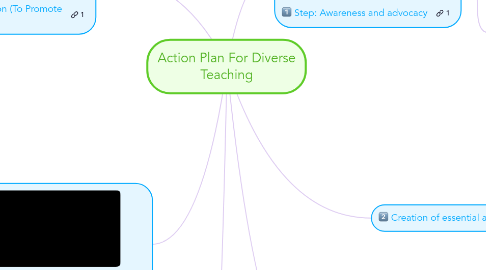Action Plan For Diverse Teaching
by Timizay Ruiz Pineda


1. Family inclusion (To Promote inclusive culture)
1.1. Who? Teachers and families
1.2. What? Invite families to take part in learning experiences
1.3. When? At least once per term or when decided by teachers during planning meetings
1.4. Where: During instruction (classroom or where instruction is taking place)
1.5. Why? To include families in the learning of students and to deepen the community understanding of cultural diversity
1.6. How? Drafting a letter or e-mail that will be send out to parents at the beginning of each unit of study encouraging their participation, support of ideas with concepts that will be taught.
2. Reflection and revision of policies and agreements
2.1. Who? Teachers and divisional admin
2.2. What? Individual reflection of teaching practice, and periodic revision of the effectiveness of the essential agreements created.
2.3. When? Individual teaching reflections to take place at the end of each unit of study and revision of essential agreements at the beginning of each school year
2.4. Where? At school, during planning and faculty meeting
2.5. Why? To measure the effectiveness of the strategies, identify personal biases and improve current practice.
2.6. How? Providing the opportunity to reflect and review as a community the practice that has been taking place
3. References Dr. Valentine, Sherry. (April 5, 2014) Strategies for Teaching Culturally Diverse Students. Retrieved from: https://www.youtube.com/watch?v=tPutaPc9gB8 CREDE. (March 31st, 2011) Effective Teaching in Diverse Classrooms. Retrieved from: https://www.youtube.com/watch?v=7d4cU4dPOQ8 Heissenbuttel, Heidi. (Dec, 22 2014) Inclusive Cultures in Schools Transforms Communities. TEDxMileHigh. Retireved from: https://www.youtube.com/watch?v=_gsbNR2pIts Brookers Publishing. (August 4, 2011) Supporting Cultural and Linguistic Diversity in Early Chilhood. Retrieved from: https://www.youtube.com/watch?v=XWg-ZrV3wPk
4. Step: Awareness and advocacy
4.1. Who? Teachers at school with a proposal begun by me
4.2. What
4.2.1. Develop a series of teacher led PDs in- campus to define diversity and advocate for the need of teaching for diversity within the faculty
4.3. When? During faculty meetings throughout the school year
4.3.1. Why? To develop cultural awareness among faculty members
4.4. Where? School assembly room
4.4.1. How? Presenting a proposal to our principal (The school has already supported these kind of initiatives in the past) and developing activities to inform and discuss with other faculty members about Culturally Responsive Teaching and Learning
5. Creation of essential agreements
5.1. Who?
5.1.1. Faculty and divisional admin.
5.2. What?
5.2.1. Creation of commonly created essential agreements that will provide the criteria for measurable effective teaching and learning. Teacher expectations, behavioral procedures, academic policies, etc.)
